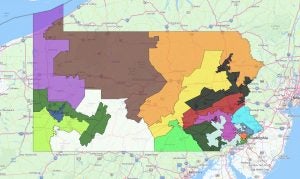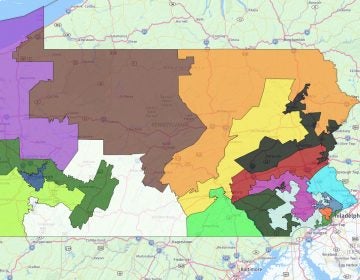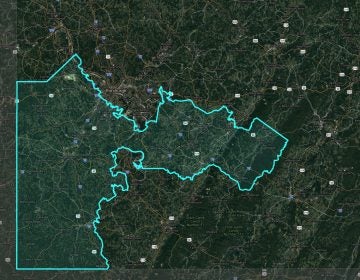Court will now decide fate of Pa. congressional map — as Wolf, Republicans can’t find compromise

(AP Photo/Matt Rourke)
The Pa. Supreme Court will now decide the shape of the state’s 18 congressional districts, as Democratic Gov. Tom Wolf and the GOP-led Legislature failed to find consensus by the court-imposed deadline.
Midnight Thursday was the last chance for petitioners to submit congressional map proposals that meet the court’s recent opinion.
When justices first declared the maps unconstitutional about four weeks ago, they ordered Wolf and the Legislature to negotiate a compromise on new ones.
That compromise never happened.
Ultimately, House and Senate Republicans, House Democrats, Senate Democrats, Governor Tom Wolf, and Lieutenant Governor Mike Stack submitted maps completely independently. Wolf submitted his minutes before the deadline.
All parties to the case were technically allowed to file maps, and several did on Thursday, including a group of Republican activists who sent in one, and two from the case’s Democratic petitioners and the League of Women Voters.
All parties’ maps vary significantly in terms of partisan advantage, though overall they do make districts more compact, and they divide fewer counties and municipalities to varying degrees.
Similar points of contention crop up across maps. Key questions include how Montgomery County is divvied up, whether the Philadelphia districts reach beyond city limits to include more likely conservative voters, which area Reading is packaged with, and whether incumbents stay in their districts.
The various parties to the case approached the redistricting process differently. House and Senate Republicans worked largely with existing staff members who have previous Pennsylvania mapping experience. They said they didn’t take partisanship into consideration at all, and ended up with a map with a relatively similar GOP advantage to the current one.
Governor Tom Wolf, on the other hand, hired Tufts University Professor Moon Duchin to consult on the map. Her analysis, he said, found that his proposal has “no partisan skew in comparison to over a billion randomly generated maps.”
The state Supreme Court has said it will either pick a map by Monday, or draw its own.
It’s unclear how exactly justices will judge the submissions.
They are being advised by Nathan Persily, a law professor from Stanford University with a background in drawing political district maps. He has previously assisted judges in New York, Connecticut, North Carolina, Georgia, and Maryland in redistricting cases.
As they have throughout the process, Republicans are calling foul over how quickly everything is moving.
The court didn’t file its full opinion until two days before the Legislature’s deadline to submit a compromise map to Wolf.
GOP leaders have said the lack of guidance is the reason they didn’t start drawing a map in earnest until 48 hours before it was due—a decision that left them no time to get a full floor vote from rank-and-file members of the Statehouse. The map that they ultimately submitted was from only Senate President Pro Tempore Joe Scarnati and House Speaker Mike Turzai.
Senate Majority Leader Jake Corman said he tried to get Governor Tom Wolf on board with asking the court for an extension and taking more time to redraw the maps.
“Unfortunately,” he said. “The governor declined that request. The governor has chosen chaos.”
The word “chaos,” in this case, is pulled from the split opinion filed by Democratic Supreme Court Justice Max Baer.
He had urged his Democratic colleagues—who hold a majority in the court—not to require lawmakers to rush a new map in time for the 2018 midterm elections, “given the substantial uncertainty, if not outright chaos, currently unfolding in this commonwealth regarding the impending election.”
It’s not just the speed of the redrawing effort that upset Corman and other Republicans, though.
They believe that the court drawing its own maps amounts to it usurping of the power of the legislative and executive branches—a situation that essentially creates a “constitutional crisis”
“We’re going to have a Stanford professor come into Pennsylvania, and he’s going to act as the prosecutor by presenting the evidence, he’s going to act as the juror by evaluating the evidence, and he solely is going to act as a judge by ultimately ruling on the evidence and producing a map—one person—to the court for the people of Pennsylvania to live under,” Corman said.
Wolf stands by the court’s decision, saying he believes it is legal.
House and Senate Republicans said if the court does in fact draw its own congressional map, they will file suit in federal court.
WHYY is your source for fact-based, in-depth journalism and information. As a nonprofit organization, we rely on financial support from readers like you. Please give today.







